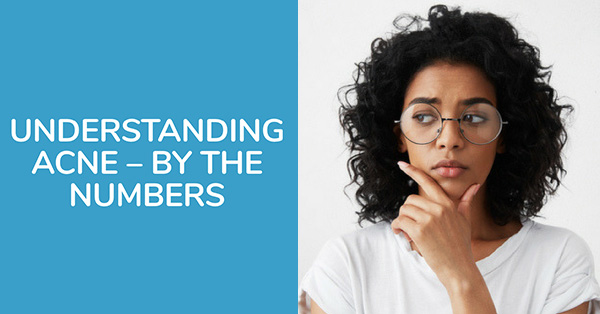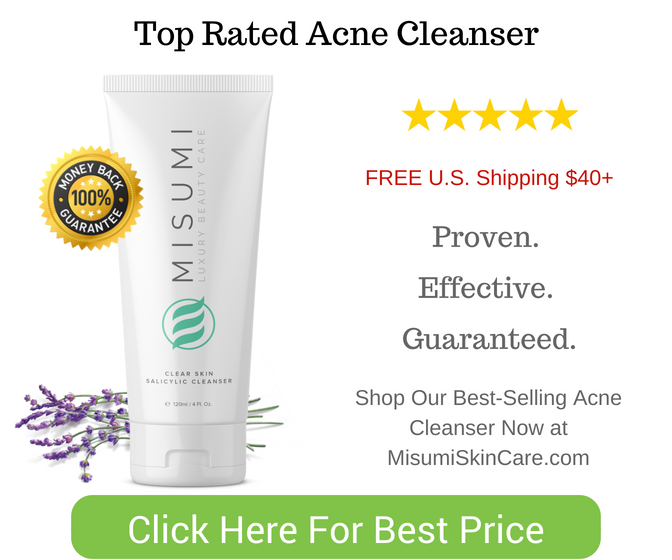Contents
Acne or acne vulgaris is one of the most prevalent skin diseases around the globe – right now an estimated number of 633 million people suffer from some kind of acne outbreak. With around 60 million cases in the US, acne vulgaris has risen to the number one skin disease in the country and the numbers are rising. Usually, Acne peaks during the puberty of boys and girls and become less frequent for young adults.
Around 40 % of adults suffer from Acne after the age of 25, whereas women are overly represented. For many people, Acne leads to severe psychological stress and social withdrawal not just people suffering from severe acne but mild acne too.
Visualizing the numbers helps to acknowledge that acne is a severe skin disorder that affects people of all ages, social and ethnic groups, and genders. It should empower them to not feel alone, don’t fear speaking up, and seeking help if needed. Additionally, the infographic is intended to increase awareness about the severe psychological consequences it has for many people. Consequences acne sufferers and non-sufferers all too often don’t pay enough attention to.
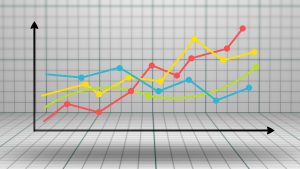
Acne Statistics – How many people suffer from Acne World-Wide?
Globally, Acne is the 8th most common skin disorder with about 633 million people suffering from it in some related context. In the US, Acne has evolved to be the most common skin disorder counting in between 50 and 60 million cases right after Eczema and Seborrheic Dermatitis. It equals up to about 18 % of the population.
The difference to developing countries, where only about 8 – 10 % of the population are affected is likely due to our high-glycolic diet, environmental influences like pollution, and/or also genetic differences.
Out of the 50 – 60 Million Americans, about 20 Million have to fight severe acne and acne scarring. Striking is that in 2013 only a total of 5 Million people sought medical treatment for acne. (American Academy of Dermatology, 2018)
Until people reach their adulthood with 25 years, an astonishing 85 % have to treat acne outbreaks in some way or the other and acne scars. The production of high levels of androgens during puberty explains these numbers to a fairly large part.
Androgens:
These are hormones that increase in boys and girls during puberty and cause the sebaceous glands to enlarge and make more sebum.
I will cover some ways of treating severe acne, adult acne, mild acne, moderate acne, acne affects, how acne develops as well as some risk factors to keep an eye out for and what can make your acne worse. If not in this article across others on this site.
Generally, acne starts with the beginning of puberty and increasing levels of androgens.
Until the age of 25, it is evenly distributed between boys and girls. Whereas Boys tend to peak a little later between 14 and 17 compared to girls whose acne peaks between 13 and 16.
Although acne is primarily perceived as a disorder of adolescence about 60 % of people continue to have acne into their adulthood and adult acne may be made worse by smoking.
Only a small fraction of people experience acne after adolescence for the first time. This fraction incorporates cases of pregnancy acne which is caused by hormonal changes during pregnancy.
With increasing, age women become overly represented this may have something to do with adult female acne being incredibly common due to hormonal changes.
About 60 % percent of the people who suffered from adult acne see an improvement over time.
Approximately 12 to 22 percent of United States women suffer from adult acne, 4 – 6 compared to three percent of men.

Recent scientific research is alarming and suggests that the prevalence of adult acne increases: Clinical and aesthetic dermatology clinics in the UK state that the number of adult patients has risen by 200 % and the average age of acne patients has increased from 20.5 to 26. 5 years.
Doctors and other skin experts expect the causes in changes in our diets, hormones and stress levels, environmental factors like pollution but also because people more commonly choose wrong skincare products that don’t suit their personal skin type.
For example, many anti-aging creams are very rich which in turn can clog pores and cause acne or even clog up hair follicles or make excess oil which may not work for treating common acne or treating acne in general. It could even increase your chance of getting blackheads which can also affect hair follicles and to treat blackheads you need a different approach.
Severe Nodulocystic Acne 11 / 16 People with severe nodulocystic acne have multiple inflamed cysts and nodules. Severe forms of acne like this one can cause an oily substance under the skin inside of papules and pustules, like yellow pus. Other treatments like staying away from greasy foods and reducing stress can make few papules and reduce hormonal factors sometimes eating chocolate can also be a good treatment for the hormonal side.
There is a myriad of different treatments for acne today, they range from over-the-counter products, antibiotics, natural remedies, laser and light treatments, acupuncture, and many more.
Some of the products turned out to be really effective for the treatment and some turned out to be a commercial scam, which is really hard to spot for individuals.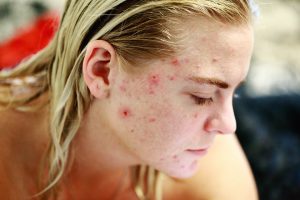
That might be partly the reason for the fact that about 40 % of people who suffer from acne are not doing anything about it.
20 % are seeking advice in skincare centres and only about 10 % percent seek advice from a physician or dermatologist. Additionally, 30 % rely on over-the-counter products in their fight against acne.
To help you choose the right over-the-counter products, we steadily evaluate which are the best products on the market.
We focus on evaluating the products regarding their effectiveness against acne, to which skin type they suit, which ingredients are being used, and whether the price is justifiable.
Acne typically develops in areas with a lot of oil glands, thus the face, chest, neck, back, arms, shoulders, and buttocks are primarily affected.
Of all people that ever experience outbreaks 99 percent exhibit outbreaks in the face and about 60 percent on the body.
Undeniably your face is the most visible area of your body and unfortunately, it is also the area where acne tends to show up the most. Typically, it is separated into the following kinds
Acne on the Cheeks
Acne around the Mouth
Acne on the Chin
Acne on the Forehead
Each of the types might be due to different causes and it is very important to inform yourself if you really want to get rid of your acne in a sustainable and long-lasting way.
For example, Acne on the forehead might be caused by reasons that lie as far from each other as a wrong cosmetic product, an unfavorable hairstyle, wrong nutrition, or the impact of the sun.
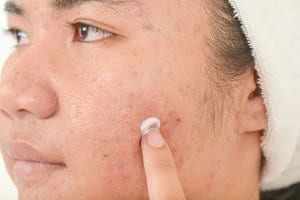 On the body, acne becomes less frequented with only about 60 percent of the people having outbreaks, but it can be just as painful, annoying, and frustrating as acne in the face.
On the body, acne becomes less frequented with only about 60 percent of the people having outbreaks, but it can be just as painful, annoying, and frustrating as acne in the face.
Technically, it is caused by the same reason as in the face but very different factors influence it. As we, for example, tend to sweat more while wearing certain types of clothes in the summer months or simply because exfoliating our back is much harder than exfoliating our face.
The most common types of acne on the body are:
Acne on the Back and Neck
Acne on the Chest
Acne on Upper Arms and Shoulders
Acne on the Buttock
Check out our detailed articles, if you like to get to know more about one or more of the types. They thoroughly describe expert opinion on causes, prevention, and treatment of the according to acne type.
Many people who suffer from acne over a longer period of time yield significant psychological consequences and associate a whole bunch of negative feelings with their skin disorder.
They are suspect to psychological stress and tend to socially withdraw themselves on a regular basis.
The negative psychological impact of acne on people’s lives is a largely neglected consequence of the skin disorder about which it is very important to increase awareness.
Adolescences in school must be better protected from bullying and educated about the potential treatments to get rid of their acne. Like washing your face thoroughly and making sure you get rid of excess dead skin cells, this is one of the many ways acne develops. Even though a successful treatment will not necessarily mean getting rid of it 100 percent, but the chances to keep acne under control to a very large degree are more than good!
Change picture of the society, reinforce support from society and family members, and show options that are available to fight psychological issues linked to common skin disease.

 Feelings that are associated with common acne range from feeling slightly depressed, embarrassed, or inferior to others to feel that significantly influence the life quality of people like severe depression, withdrawal from social activities, or developing self-esteem issues.
Feelings that are associated with common acne range from feeling slightly depressed, embarrassed, or inferior to others to feel that significantly influence the life quality of people like severe depression, withdrawal from social activities, or developing self-esteem issues.
I deeply encourage people who feel like their acne is impacting their mental well-being to consult a doctor, therapist, or local care center.
Even starting to talk about your feelings with your friends or family is a step in the right direction – don’t leave it to chance that your acne will disappear at some point.
There are plenty of opportunities to get rid of your acne or at least keep it under control, don’t waste your precious time waiting for relief!
Whiteheads
Comedones that stay closed at the surface of the skin are called whiteheads. This happens when oil and skin cells prevent a clogged hair follicle from opening. These are nothing to worry about and in fact, many over-the-counter brands including benzoyl peroxide can help to reduce these forms of acne flares and prevent acne signs going forward.
There are prescription drugs that you can be prescribed by your family doctor for common skin disorders that may even help to reduce these which may include salicylic acid.
How do numbers evolve in future?
The UK the Telegraph reports that the increase in Adult Acne cases is “like an epidemic”. A study finds that in 92 private dermatology clinics the numbers of adults seeking specialist acne treatment have risen by around 200 percent since the previous year.
The possible explanation for those rising numbers varies from changes in genetics, diets, environmental pollution, hormones, and stress but also the myriad of new skincare products we use.
Dr. Stefanie Williams (Medical Director of the European Dermatology London) states that the social ideal of constantly trying to look young strongly contributes to the increasing cases of adult acne.
Especially anti-aging skin products tend to have very rich ingredients, which can be a great treatment for skin which could see significant improvement for one condition though can lead to outbreaks of others and may cause a clogged pore or hair follicles.
Additionally, especially in cities increasing environmental pollution leads to high levels of toxins and microparticles of dirt in the air that are prone to clog pores, irritate the skin, and cause infections.
Also, the increase in irritation to the skin can cause a build-up of dead skin cells which then cause further problems.
Rising stress hormone levels due to increasing pollution, noise levels, or insecure working conditions also contribute to the rise.
While correlation never means causation until it is scientifically proven, comparing numbers of acne cases in the third-world countries that differ in diets, levels of pollution, and stress with the number of acne cases in first-world countries we can see a significant difference.

